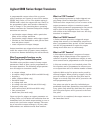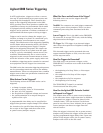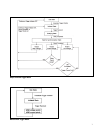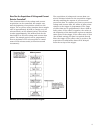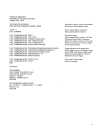
6
In ATE applications, triggers are often a conven-
ient way of synchronizing test system events and
increasing test throughput. These benefits also
apply to the triggering subsystems in the 6800
series products since these products combine the
capabilities of many test instruments. Each model
is equipped with the ability to send and receive
triggers, and to perform or initiate a multitude of
synchronized functions upon receiving a trigger.
Triggers can be used to change the output, syn-
chronize a change to a phase of a waveform cycle,
and synchronize a measurement to an output
change. The effectiveness of the triggering capability
can be shown when measuring worst case inrush
current of a switching power supply. Using the
6800 series triggering subsystem, the output can
be triggered to turn on at a phase near the peak
of the ac cycle for simulating a worst case ac line
condition. Simultaneously, the ac source can be
triggered to take current measurements to charac-
terize the behavior of the power supply under test.
In addition, triggering can be extended to external
test equipment via the Trigger Out connection.
The 6800 series has two main triggering subsystems,
one for generating transients and one for making
measurements. These two subsystems have common
trigger sources that can synchronize transient and
measurement events.
What Actions Can be Triggered?
The following actions of the 6800 series can be
triggered:
• a change in output setting
• the start of a Step, Pulse, or List transient
• the pace of a List sequence
• the acquisition of digitized voltage and current
• the synchronization of an output change to
a phase of the cycle
A programmable time delay can be specified for
triggers that generate output changes. This allows
the insertion of a specified time delay between
the receipt of the trigger and the action of the
ac power source/analyzer output.
What Can Serve as the Source of the Trigger?
The 6800 series can receive triggers from the
following sources:
The GPIB. The computer can send trigger commands
to the ac power source/analyzer. There is a short
command processing time associated with this
source.
External Trigger In. This is the 6800 series TRIGGER
IN connector. It accepts TTL levels, with the falling
edge detected as the trigger.
TTL Trigger. The TTL trigger is an internal trigger
that causes the acquisition of digitized voltage and
current data.
This internal trigger can be generated when an
output transient begins or ends, or as the result
of List step execution.
How Can Triggers be Generated?
The 6800 series can generate a trigger on the
TRIGGER OUT connector as a result of the follow-
ing actions:
• the beginning of a Step, Pulse, or List output
transient
• the completion of a Step or Pulse output
transient
• the completion of a List sequence
• the beginning of a List step
The TRIGGER OUT signal is a nominal
10-microsecond low-true pulse.
How Can the Agilent 6800 Series be Enabled
to Respond to a Trigger?
The default state of the ac power source/analyzer
is the idle state where trigger detection is disabled.
To respond to a trigger, it must be placed in the
“initiated state.” This can be done via the front
panel or over the bus. Once initiated, the ac power
source/analyzer can detect a trigger from the
selected source.
When the trigger is detected, the ac power source/
analyzer will perform the trigger action after wait-
ing any programmed trigger delay time. Upon com-
pletion of the trigger action, the ac power source/
analyzer will return to the idle state.
Agilent 6800 Series Triggering






